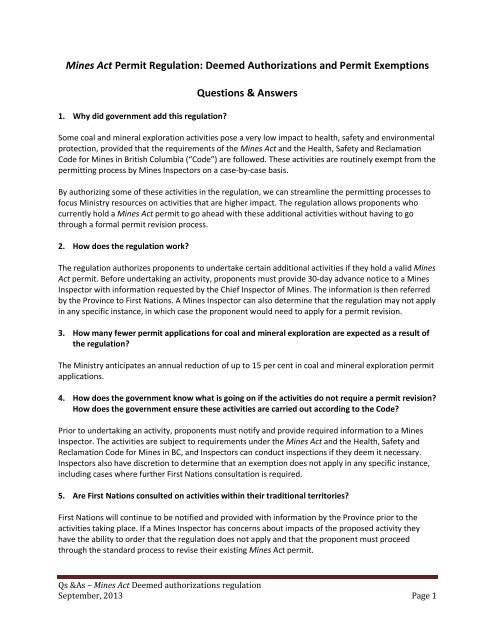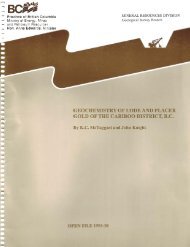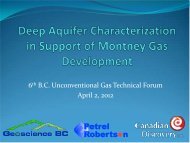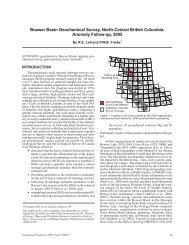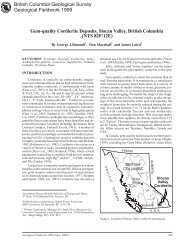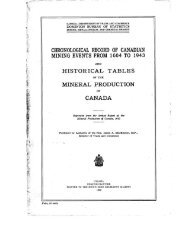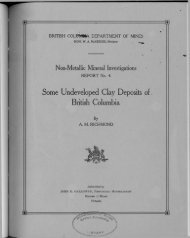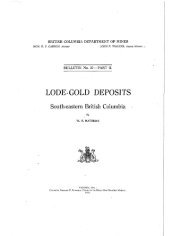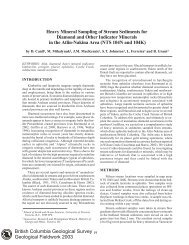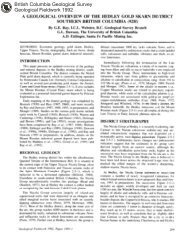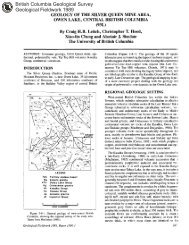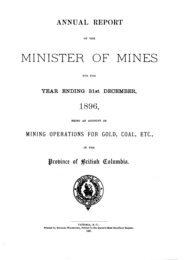Mines Act Permit Regulation - Ministry of Energy and Mines
Mines Act Permit Regulation - Ministry of Energy and Mines
Mines Act Permit Regulation - Ministry of Energy and Mines
You also want an ePaper? Increase the reach of your titles
YUMPU automatically turns print PDFs into web optimized ePapers that Google loves.
<strong>Mines</strong> <strong>Act</strong> <strong>Permit</strong> <strong>Regulation</strong>: Deemed Authorizations <strong>and</strong> <strong>Permit</strong> Exemptions<br />
1. Why did government add this regulation?<br />
Questions & Answers<br />
Some coal <strong>and</strong> mineral exploration activities pose a very low impact to health, safety <strong>and</strong> environmental<br />
protection, provided that the requirements <strong>of</strong> the <strong>Mines</strong> <strong>Act</strong> <strong>and</strong> the Health, Safety <strong>and</strong> Reclamation<br />
Code for <strong>Mines</strong> in British Columbia (“Code”) are followed. These activities are routinely exempt from the<br />
permitting process by <strong>Mines</strong> Inspectors on a case-by-case basis.<br />
By authorizing some <strong>of</strong> these activities in the regulation, we can streamline the permitting processes to<br />
focus <strong>Ministry</strong> resources on activities that are higher impact. The regulation allows proponents who<br />
currently hold a <strong>Mines</strong> <strong>Act</strong> permit to go ahead with these additional activities without having to go<br />
through a formal permit revision process.<br />
2. How does the regulation work?<br />
The regulation authorizes proponents to undertake certain additional activities if they hold a valid <strong>Mines</strong><br />
<strong>Act</strong> permit. Before undertaking an activity, proponents must provide 30-day advance notice to a <strong>Mines</strong><br />
Inspector with information requested by the Chief Inspector <strong>of</strong> <strong>Mines</strong>. The information is then referred<br />
by the Province to First Nations. A <strong>Mines</strong> Inspector can also determine that the regulation may not apply<br />
in any specific instance, in which case the proponent would need to apply for a permit revision.<br />
3. How many fewer permit applications for coal <strong>and</strong> mineral exploration are expected as a result <strong>of</strong><br />
the regulation?<br />
The <strong>Ministry</strong> anticipates an annual reduction <strong>of</strong> up to 15 per cent in coal <strong>and</strong> mineral exploration permit<br />
applications.<br />
4. How does the government know what is going on if the activities do not require a permit revision?<br />
How does the government ensure these activities are carried out according to the Code?<br />
Prior to undertaking an activity, proponents must notify <strong>and</strong> provide required information to a <strong>Mines</strong><br />
Inspector. The activities are subject to requirements under the <strong>Mines</strong> <strong>Act</strong> <strong>and</strong> the Health, Safety <strong>and</strong><br />
Reclamation Code for <strong>Mines</strong> in BC, <strong>and</strong> Inspectors can conduct inspections if they deem it necessary.<br />
Inspectors also have discretion to determine that an exemption does not apply in any specific instance,<br />
including cases where further First Nations consultation is required.<br />
5. Are First Nations consulted on activities within their traditional territories?<br />
First Nations will continue to be notified <strong>and</strong> provided with information by the Province prior to the<br />
activities taking place. If a <strong>Mines</strong> Inspector has concerns about impacts <strong>of</strong> the proposed activity they<br />
have the ability to order that the regulation does not apply <strong>and</strong> that the proponent must proceed<br />
through the st<strong>and</strong>ard process to revise their existing <strong>Mines</strong> <strong>Act</strong> permit.<br />
Qs &As – <strong>Mines</strong> <strong>Act</strong> Deemed authorizations regulation<br />
September, 2013 Page 1
6. How are health <strong>and</strong> safety maintained?<br />
Mining <strong>and</strong> mineral exploration is one <strong>of</strong> the safest heavy industries in B.C. Only activities that are low<br />
impact in nature were considered for inclusion in the regulation. Proponents will still be required to<br />
comply with all conditions <strong>and</strong> requirements <strong>of</strong> the existing permit, the <strong>Mines</strong> <strong>Act</strong> <strong>and</strong> the Health, Safety<br />
<strong>and</strong> Reclamation Code for <strong>Mines</strong> in BC. <strong>Act</strong>ivities are subject to inspection.<br />
7. How is the environment protected?<br />
Proponents are required to meet all <strong>of</strong> the conditions <strong>and</strong> requirements <strong>of</strong> the existing permit, <strong>Mines</strong><br />
<strong>Act</strong> <strong>and</strong> Code, including requirements for environmental protection <strong>and</strong> reclamation. In addition, <strong>Mines</strong><br />
Inspectors have the ability to order that the regulation does not apply <strong>and</strong> that the proponent must<br />
apply for a revision to their existing <strong>Mines</strong> <strong>Act</strong> permit. The Inspector could then add conditions to ensure<br />
environmental protection in the specific circumstances. Authorized activities are subject to inspections<br />
<strong>and</strong> compliance <strong>and</strong> enforcement.<br />
8. How did the government determine which activities were low impact?<br />
Government considered the health <strong>and</strong> safety record <strong>and</strong> record <strong>of</strong> environmental impact to determine<br />
whether or not activities posed a negligible impact to health, safety, the environment or cultural<br />
heritage resources.<br />
9. How does this help reduce the backlog <strong>of</strong> exploration permits?<br />
By removing these applications from the permitting system, <strong>Mines</strong> Inspectors can focus their resources<br />
on higher impact activities <strong>and</strong> inspections. By reducing the administrative burden on <strong>Mines</strong> Inspectors,<br />
the <strong>Ministry</strong> can increase the amount <strong>of</strong> time spent in the field conducting inspections <strong>and</strong> ensuring<br />
compliance.<br />
10. Were First Nations <strong>and</strong> the public consulted?<br />
A 30-day public consultation was held on the <strong>Ministry</strong>’s Discussion Paper from November 22 to<br />
December 24, 2012. A discussion paper was made available on the <strong>Ministry</strong> website along with an<br />
electronic feedback form. In developing the list <strong>of</strong> exempt activities for this broad consultation, the<br />
<strong>Ministry</strong> sought input from the First Nations <strong>Energy</strong> <strong>and</strong> Mining Council, the Association for Mineral<br />
Exploration British Columbia <strong>and</strong> the Mining Association <strong>of</strong> BC. The <strong>Ministry</strong> received 37 comments<br />
from the public, First Nations, <strong>and</strong> industry during the consultation period, <strong>and</strong>, based on feedback,<br />
developed the final list <strong>of</strong> activities <strong>and</strong> conditions for inclusion in the regulation. First Nations in<br />
particular identified a strong preference for notification <strong>of</strong> activities from the Province, not proponents,<br />
<strong>and</strong> this has been included in the regulation.<br />
11. What’s different between the Discussion Paper <strong>and</strong> the regulation?<br />
Proposed administrative name changes in the Discussion Paper were not included in the regulation.<br />
These can be dealt with through procedural policy. As well, under the regulation, exploration drill<br />
programs can only be carried out within the area <strong>of</strong> disturbance <strong>of</strong> a producing, operating mine. In order<br />
Qs &As – <strong>Mines</strong> <strong>Act</strong> Deemed authorizations regulation<br />
September, 2013 Page 2
to address concerns raised by First Nations during Discussion Paper consultation, notification will come<br />
from the Province to First Nations, not from proponents.<br />
12. How does this link to the mineral claims issue on Pender Isl<strong>and</strong>? Could claims holders undertake<br />
these activities on those private l<strong>and</strong>s?<br />
A <strong>Mines</strong> <strong>Act</strong> permit is required before any <strong>of</strong> the allowed activities under the regulation would apply.<br />
Part <strong>of</strong> the review <strong>of</strong> a <strong>Mines</strong> <strong>Act</strong> permit application involves consultation with potentially affected<br />
l<strong>and</strong>owners. <strong>Mines</strong> Inspectors would consider <strong>and</strong> address potential impacts to l<strong>and</strong>owners before<br />
issuing a permit.<br />
13. How does the regulation address the issues raised in the Ross River Dena v Government <strong>of</strong> Yukon<br />
decision?<br />
In order for an activity to be authorized under the regulation, a proponent must already hold a <strong>Mines</strong><br />
<strong>Act</strong> permit for which consultation with First Nations was conducted. Notification to First Nations must<br />
also occur prior to the activity being undertaken, <strong>and</strong> First Nations can raise any issues or concerns<br />
directly with <strong>Mines</strong> Inspectors. <strong>Mines</strong> Inspectors can determine that the regulation does not apply in<br />
any specific instance, in which case the proponent will be required to apply for a permit revision.<br />
14. Why was the <strong>Ministry</strong> <strong>of</strong> Transportation <strong>and</strong> Infrastructure given an exemption from permitting in<br />
the regulation? What mining do they undertake, <strong>and</strong> how will health, safety <strong>and</strong> environmental<br />
protection be ensured?<br />
Under the regulation, aggregate mines that are operated exclusively by or on behalf <strong>of</strong> the <strong>Ministry</strong> <strong>of</strong><br />
Transportation <strong>and</strong> Infrastructure will be exempt from the requirement to hold a <strong>Mines</strong> <strong>Act</strong> permit,<br />
except in cases where an environmental assessment is required. These mines – typically involving<br />
removal <strong>of</strong> s<strong>and</strong>, gravel <strong>and</strong> rock – provide the material needed to construct <strong>and</strong> maintain highways <strong>and</strong><br />
other provincial transportation infrastructure. The aggregate may also be used in cases <strong>of</strong> provincial<br />
emergencies, such as flooding. The <strong>Ministry</strong> <strong>of</strong> Transportation <strong>and</strong> Infrastructure will continue to be<br />
subject to all <strong>of</strong> the requirements <strong>of</strong> the <strong>Mines</strong> <strong>Act</strong> <strong>and</strong> the Code, <strong>and</strong> be subject to inspections.<br />
15. Why was the aggregate exemption not included in the Discussion Paper?<br />
Because the aggregate exemption was only provided for <strong>Ministry</strong> <strong>of</strong> Transportation <strong>and</strong> Infrastructure<br />
aggregate mines, the <strong>Ministry</strong> consulted directly with MOTI. The exemption does not change any <strong>of</strong> the<br />
requirements for consultation with First Nations or stakeholders on the creation <strong>of</strong> l<strong>and</strong> reserves for<br />
these mines.<br />
16. What work did the <strong>Ministry</strong> do to prepare for the regulation in-force date <strong>of</strong> September 1, 2013?<br />
The <strong>Ministry</strong> worked with the <strong>Ministry</strong> <strong>of</strong> Forests, L<strong>and</strong>s <strong>and</strong> Natural Resource Operations to ensure<br />
proponents could provide all <strong>of</strong> the necessary information through Virtual FrontCounter BC. The<br />
<strong>Ministry</strong> worked with the <strong>Ministry</strong> <strong>of</strong> Aboriginal Relations <strong>and</strong> Reconciliation to ensure all First Nation<br />
participants in strategic engagement agreements with the Province are aware <strong>of</strong> the regulation <strong>and</strong> how<br />
engagement will be conducted. Written information <strong>and</strong> guidance for industry <strong>and</strong> the public has also<br />
been developed.<br />
Qs &As – <strong>Mines</strong> <strong>Act</strong> Deemed authorizations regulation<br />
September, 2013 Page 3


